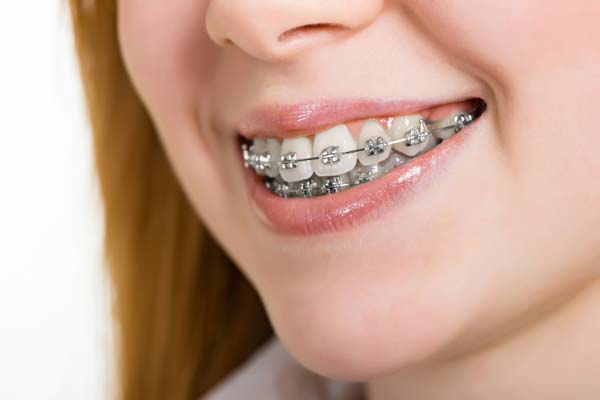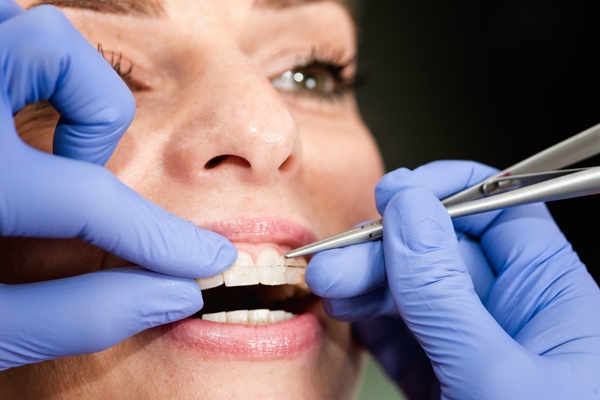How Are Corrective Braces Different From Aesthetic Braces?

Corrective braces are teeth straightening devices that are used to fix crooked teeth and correct bites. The most popular types of braces are traditional metal braces, but their popularity has waned in recent years because many people are instead choosing aesthetic braces to fix their teeth.
Differences between corrective braces and aesthetic braces
Corrective braces and aesthetic braces serve the same primary function, which is to straighten out your teeth. However, the similarities stop there. Braces that are considered corrective include traditional braces and ceramic braces, while clear aligners are considered aesthetic braces.
Corrective braces
Traditional metal braces are called corrective braces because they are used to fix problems with your teeth and tend to be the most effective device to do so. Metal brackets are attached to the surface of your teeth and tightened to gradually move your teeth into the desired positions.
In the past, the brackets used were bigger, but the size has been significantly reduced in recent years to make them more appealing. Still, people who need corrective braces are switching to ceramic braces and clear aligners because they are less visible.
Ceramic braces are just as effective as metal braces, with the only difference being that the brackets are made from ceramic instead of metal. Despite the brackets used for ceramic braces being larger than the those used with metal braces, ceramic braces are more popular because the brackets can be color matched to your teeth, making them difficult to notice.
Aesthetic braces
Even though clear aligners are also used to straighten teeth, they are considered aesthetic braces because of their appealing appearance. The aligners are made from clear plastic and are impossible to notice, allowing people to straighten their teeth without being self-conscious about smiling, which is something many people with metal braces go through.
Lingual braces work like metal braces and ceramic braces but are also considered aesthetic braces instead of corrective because the brackets are installed on the inside surface of your teeth and are not visible when you smile.
Other differences between corrective braces and aesthetic braces include:
- Cost: Traditional braces are more cost-effective than aesthetic braces, which are more expensive because of the materials they are made from and because they are not noticeable when you have them in your mouth
- Cleaning: Aesthetic braces like clear aligners are easier to clean than corrective braces because they can be removed, allowing you to clean them properly with ease; corrective braces require more time to clean because you have to remove the food particles that get stuck in the brackets and wires.
- Eating: Eating with aesthetic braces is also easier because you can eat whatever you want since you can remove them before eating to avoid having food particles stuck in them; corrective braces require you to avoid certain foods in order to prevent damage to the braces
Conclusion
Corrective braces and aesthetic braces do the same job. However, corrective braces get the job done quicker than aesthetic braces. If you are considering straightening your teeth, talk to your dentist to get more information about the types of braces that are available so you can make a well-informed decision.
Request an appointment here: https://www.bracesbyabbadent.com or call Braces By Abbadent at (563) 484-5202 for an appointment in our Dubuque office.
Check out what others are saying about our dental services on Yelp: Braces.
Recent Posts
You may have seen someone wearing ceramic braces without even knowing it. These are most well-known for their discreet appearance and are ideal alternatives for patients who are concerned about how noticeable their braces would look. Read on to learn more about why ceramic braces are trusted among orthodontic professionals.Ceramic braces are among the most…
Space maintainers are great resources that are used in dentistry and orthodontics. They are small, metal dental pieces that are placed where a tooth once was, whether it be an adult or baby tooth. Keep reading to find out more about space maintainers.Outlined below are a few things to know about space maintainers, including what…
Orthodontic treatments are not just for children and teenagers. Adult braces are becoming increasingly popular due to advancements in orthodontic technology and the growing awareness of the importance of a healthy, well-aligned bite. For those considering adult braces, there are a few key things to remember before starting the journey toward a straighter smile. Misaligned…
Teeth straightening is a popular dental procedure for people who want to improve their smile. There are several methods that people can choose from that can resolve a wide range of dental issues. If you want straighter teeth, you can definitely benefit from orthodontic treatment. Read on to learn about the different types of braces…


